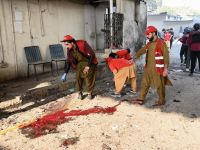KAF Contemporary art gallery’s new exhibition “Raw” is an innovative live-painting collaboration that seeks to redefine the role of artist, gallery and viewer.
Lebanon-based artists Sara Chaar, Fadi El Chamaa and Semaan Khawam spent 21 consecutive days making work shoulder to shoulder in the Ashrafieh gallery. The project is based on “Sleeping with the Enemy,” a similar 21-day project featuring longtime friends Chamaa and Khawam and their colleague Ghylan Safadi.
While the artists mostly worked on their own pieces, they were constantly chatting and offering thoughts on each other’s work.
“There is a transfer that happens when you start working with somebody,” Chamaa said. “Without feeling it, you start taking some visions that are common to the three.”
“It’s all about the dialogue,” Khawam added.
This creative interaction included the public as well as the artists.
Every workday, from 4-11 p.m., the gallery was open for anyone to join the conversation. Many visitors were random passersby, and the artists said the fresh perspectives enriched everyone’s work.
“It’s always good to meet people,” gallery curator Randa Ghajar said. “You always learn from anybody, from everybody.”
“You would never dream of something like that happening in a conventional shop,” Khawam added, “not even in your studio, because you’re locked in. Here, all the doors are open.”
{"preview_thumbnail":"https://cdn.flowplayer.com/6684a05f-6468-4ecd-87d5-a748773282a3/i/v-i-c…","video_id":"cdf4f86d-2ff6-43e8-9055-ff466b22f972","player_id":"8ca46225-42a2-4245-9c20-7850ae937431","provider":"flowplayer","video":"Jordan: Israel's 'Pilgrim Road' Under Silwan to Al Aqsa is Illegal"}
The spirit of collaboration extended to the works, of which the artists have agreed to share ownership. The proceeds of any sale will be split evenly among the three and the gallery.
All prices have been reduced to make the exhibition more accessible. This means that they all make less money than they might through conventional sales, but the collaborators see the spirit of cooperation and equity as integral to the project. “It is an act of solidarity,” Chamaa said, “a kind of union of artists.”
The atmosphere of the gallery reflected this cooperative attitude.
With tables, paints and canvases strewn all over, it was a far cry from the clean, glass-clad environment of a conventional art exhibition.
For Ghajar, who acquired the gallery six months ago, that was the whole point. “I didn’t see myself as this gallerist who’s going to hang pictures on the walls and wait for the client to buy,” she said. “So this was a dream come true.”
For the artists, too, the messy, collaborative environment helped them break their usual molds and find new directions. Chaar, who used to work strictly in black-and-white, was scribbling on a piece for Khawam one day when the shades of brown she was using caught her eye. She began experimenting with color, and several of her pieces for the exhibition ended up employing earth tones. “In the way we think, we’re very different, and I think that was very good inspiration,” Chaar said. “There was a lot of evolution in my work.”
“We are on completely different platforms.” Khawam said.
“We don’t agree on politics. We don’t agree on music. We don’t agree on philosophy - anything, but this disagreement, and the debate it creates, is important.”
He stressed that working together through disagreement was something sorely needed in the art world, and in society in general.
Ultimately they all agreed that their art was most important.
“We agree on the aesthetics of things,” Khawam said. “Art is what makes this tolerable.”
At the exhibition opening, the aesthetic novelty of the project shone through. While the artists clearly retained their stylistic integrity, they also felt they’d moved in new and interesting directions, innovating with color, line and form.
While the neatly arranged paintings and scrubbed floors belied the chaotic whirlwind of the previous days, the artists’ constant banter and the affable energy distinguished the event.
On a single wall near the back of the gallery were a handful of paintings that blended the styles of the three artists. Fully collaborative pieces, these canvases had been touched by all three painters’ hands and brushes.
“What we are trying to achieve,” Chamaa said, “is to have one vision of what we want to do.”
The artists agreed these collaborative paintings didn’t appear to have emerged from a single mind.
“Now each has his own vision. It’s as if you have three styles and you’re mixing them on Photoshop,” Chamaa said. “We need a lot of work.”
Moving forward, the three artists said they’d continue collaborating at their shared studio. Ghajar expressed hope KAF would host more cooperative live-painting projects with other artists, advancing her vision of the open gallery as a nexus of disagreement, dialogue and aesthetic innovation.
“Raw” is up at KAF Contemporary art gallery through July 8.
This article has been adapted from its original source.








